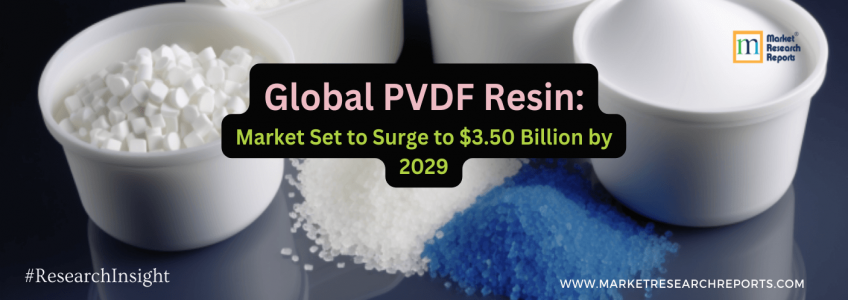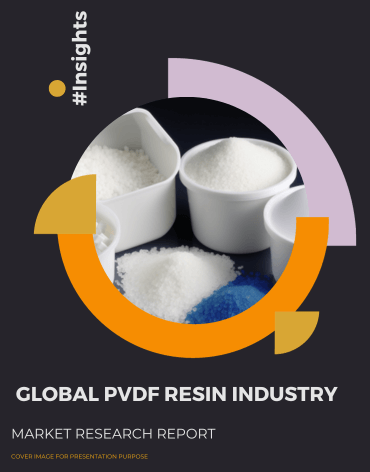Global PVDF Resin Market Set to Surge to USD 3.50 Billion by 2029

Polyvinylidene fluoride, commonly abbreviated as PVDF, is a synthetic polymer made from the monomer vinylidene fluoride. It is a versatile and widely used material known for its excellent chemical resistance, high-temperature stability, electrical insulation properties, and robust mechanical properties. PVDF is used in various industries and applications, including:
Chemical Processing: PVDF is often used in the chemical industry due to its resistance to a wide range of chemicals, including acids, bases, and solvents. It is used for making pipes, fittings, and valves for transporting corrosive fluids.
Electrical and Electronics: PVDF's excellent electrical insulation properties make it suitable for wire and cable insulation, as well as for components in the electronics industry. It is used to manufacture capacitors, piezoelectric devices, and sensors.
Construction: PVDF is used as a coating material for architectural structures, especially in the form of PVDF-coated aluminum panels. These panels provide weather resistance, UV resistance, and an aesthetically pleasing finish to buildings.
Aerospace: In the aerospace industry, PVDF is used for components that require high-performance materials, such as fuel lines and ducts, due to its ability to withstand extreme temperatures and its resistance to aviation fuels.
Oil and Gas: PVDF is used in the oil and gas industry for various applications, including pipes, fittings, and linings for equipment used in the extraction and transportation of oil and gas.
Medical: PVDF is used in medical devices and equipment due to its biocompatibility. It is used in applications such as catheters, tubing, and surgical instruments.
Water Treatment: PVDF membranes are used in water treatment processes for filtration and purification purposes.
Automotive: PVDF is used in automotive applications, including fuel lines, hoses, and connectors, where resistance to chemicals and temperature stability is crucial.
Textiles: PVDF coatings can be applied to fabrics to make them water and stain-resistant.
Battery Technology: PVDF is used as a binder material in lithium-ion batteries, helping to improve the performance and stability of the battery.
PVDF is known for its high melting point, excellent UV resistance, and its ability to maintain its mechanical properties over a wide range of temperatures. It is often processed through methods like injection molding, extrusion, and compression molding to produce various products in different forms, including sheets, films, rods, and tubes.
1 . PVDF Market Scenario
- The global PVDF resin market was valued at US$ 2,387.39 million in 2023.
- It is anticipated to reach US$ 3,502.13 million by 2029.
- The market is expected to witness a Compound Annual Growth Rate (CAGR) of 6.59% during the forecast period of 2023-2029.
- The impact of COVID-19 and the Russia-Ukraine War were taken into consideration while estimating market sizes.
North American PVDF Resin Market:
- The North American market for PVDF resin is estimated to grow from $348.76 million in 2023 to reach $432.68 million by 2029.
- This represents a CAGR of 3.66% during the forecast period from 2023 through 2029.
Chinese PVDF Resin Market:
- The Chinese market for PVDF resin is estimated to increase from $1,295.11 million in 2023 to reach $2,057.93 million by 2029.
- This signifies a CAGR of 8.02% during the forecast period of 2023 through 2029.
2 . Types of PVDF
PVDF (Polyvinylidene fluoride) is available in various forms, including PVDF powder and PVDF granules. These different forms cater to specific applications and processing methods. Here's a brief overview of each:
PVDF Powder:
- PVDF powder is finely ground PVDF resin in powder form. It is a raw material used in various manufacturing processes to produce PVDF-based products.
- Applications:
- Coating: PVDF powder can be used as a raw material for creating PVDF coatings, which are applied to surfaces through processes like powder coating.
- Processing: PVDF powder can be used as a starting material in processes like compression molding, which involves applying heat and pressure to shape PVDF components.
- Additive: It can also be added as an ingredient or additive in various formulations, such as in the production of adhesives, sealants, and certain plastics.
- Powder form allows for precise control over the amount used in formulations or processes.
PVDF Granule:
- PVDF granules are larger, pellet-like forms of PVDF resin. These granules are often used in extrusion and injection molding processes.
- Applications:
- Extrusion: PVDF granules can be melted and extruded to create various products like pipes, tubes, and sheets. In the extrusion process, the granules are heated and forced through a die to form the desired shape.
- Injection Molding: They can also be used in injection molding, where the granules are melted and injected into a mold to produce complex 3D shapes and components.
- Additive Manufacturing: In some cases, PVDF granules can be used as a feedstock material for 3D printing, particularly in processes like fused deposition modeling (FDM).
- Granules are convenient for processes that involve melting and shaping PVDF into specific forms, especially when precision and repeatability are crucial.
The choice between PVDF powder and PVDF granules depends on the intended application and the manufacturing process. Powder is typically used in applications where precise control over the PVDF content or where coating processes are involved. Granules are favored for processes like extrusion and injection molding, where melting and shaping are required. Both forms leverage PVDF's desirable properties, such as chemical resistance, thermal stability, and electrical insulation, depending on the application's requirements.
3 . PVDF Industry Applications
Polyvinylidene fluoride (PVDF) is a versatile material with a wide range of applications. Here are some common applications of PVDF in various forms:
Coating:
- PVDF is used as a coating material in architectural applications for its weather resistance and UV stability. It provides an aesthetically pleasing finish to buildings and is often used on aluminum panels.
Injection/Extrusion Products:
- PVDF can be processed through injection molding and extrusion to create various products such as pipes, fittings, valves, and components for chemical processing and industrial applications due to its excellent chemical resistance.
Lithium-ion Battery Binders:
- PVDF is used as a binder material in the manufacturing of lithium-ion batteries. It helps hold the electrode materials together, improving the battery's performance and stability.
Photovoltaic Film:
- PVDF is used in the production of photovoltaic (solar) films. It is applied as a protective and encapsulating layer in solar panels to enhance their durability and weather resistance.
Water Treatment Membranes:
- PVDF membranes are used in water treatment processes, particularly in filtration and purification systems. They can effectively separate impurities and contaminants from water, making them suitable for various industrial and municipal applications.
These applications highlight the diverse properties and capabilities of PVDF, making it a valuable material in industries such as construction, energy, electronics, water treatment, and more. Its chemical resistance, thermal stability, and electrical insulation properties make it suitable for demanding and specialized applications across various sectors.
4 . Leading Company at a Glance : 3M
3M is a diversified global company that offers a wide range of products, including materials made from polyvinylidene fluoride (PVDF). PVDF is a high-performance thermoplastic polymer known for its excellent chemical resistance, UV resistance, and electrical properties. 3M manufactures and markets various PVDF-based products, and some of these may include:
3M™ Dyneon™ PVDF Resins: 3M's Dyneon™ brand offers PVDF resins that are used as a base material for various applications. These resins are highly regarded for their chemical resistance, UV resistance, and flame-retardant properties. They are used in industries such as chemical processing, oil and gas, and electronics.
3M™ Dyneon™ PVDF Films: 3M produces PVDF films under the Dyneon™ brand, which are used in applications requiring durable and high-performance materials. These films are commonly used in the electronics industry for printed circuit boards, as well as in the chemical industry for lining and membrane applications.
3M™ Dyneon™ PVDF Coatings: 3M manufactures PVDF-based coatings under the Dyneon™ brand. These coatings are known for their exceptional weatherability, UV resistance, and chemical resistance. They are often used to protect and enhance the durability of architectural surfaces, including metal panels, roofs, and facades.
3M™ Dyneon™ PVDF Extruded Tubes and Pipes: 3M offers PVDF extruded tubes and pipes that are corrosion-resistant and suitable for conveying a wide range of chemicals in various industries. These products are used in applications where chemical resistance and durability are critical, such as in the chemical processing industry.
3M™ Dyneon™ PVDF Powders: PVDF powders from 3M's Dyneon™ brand are used in various coating applications, including powder coating for metal surfaces. They provide excellent chemical resistance and can be used to protect and enhance the aesthetics of metal components.
3M™ Dyneon™ PVDF Additives: 3M may also offer additives and modifiers compatible with PVDF resins to tailor the material properties for specific applications. These additives can enhance aspects like flexibility, thermal conductivity, and processability.
3M™ Dyneon™ PVDF Binders: PVDF binders are used in the production of advanced materials, such as lithium-ion battery electrodes and separators. These binders are known for their chemical stability and ability to improve the performance of energy storage devices.






